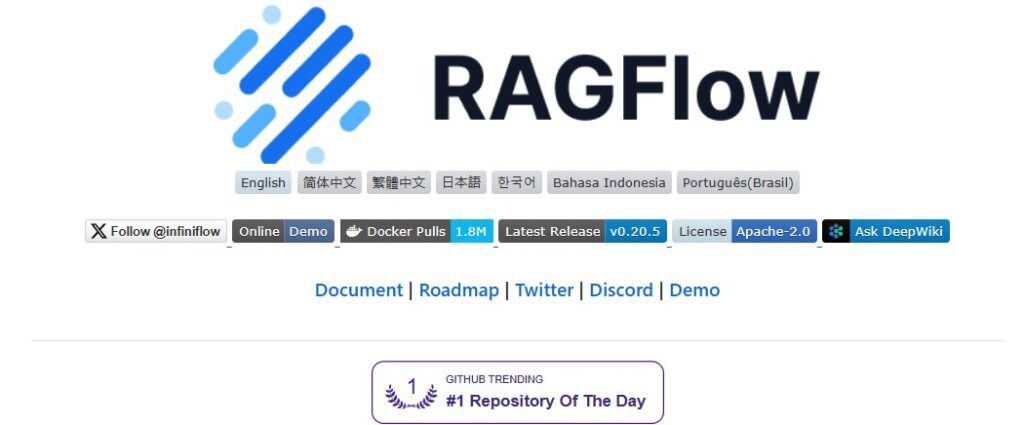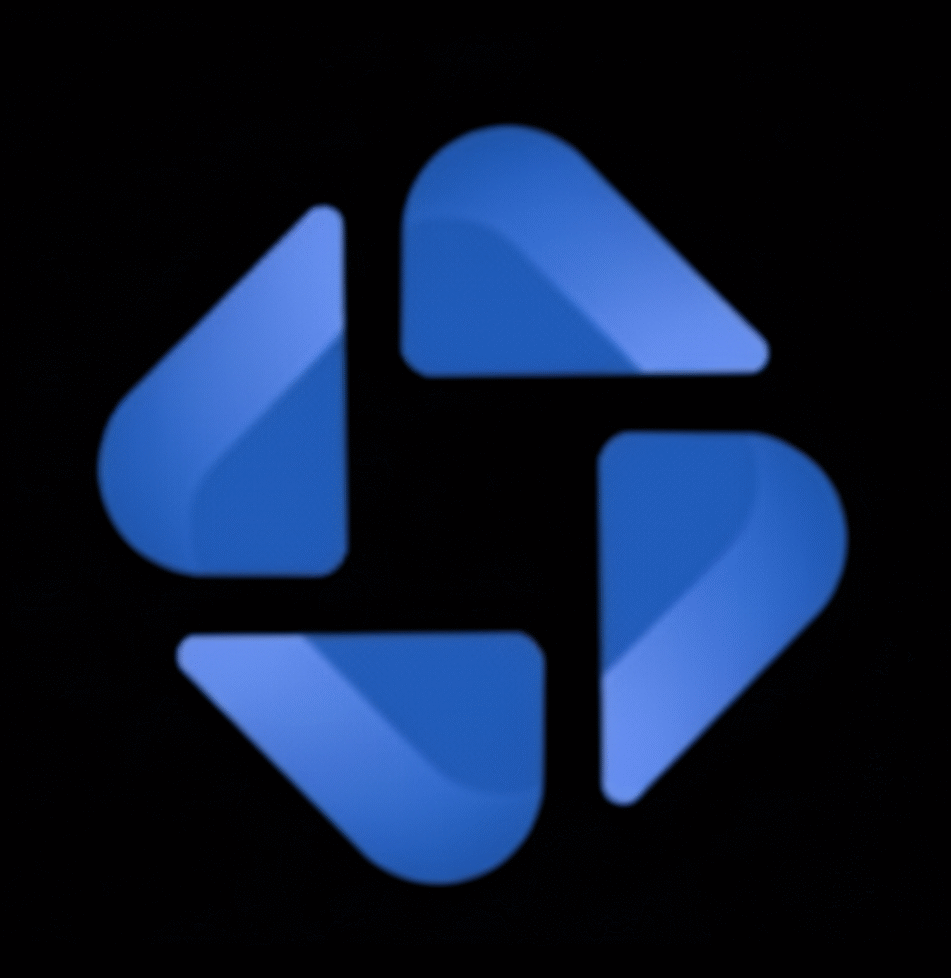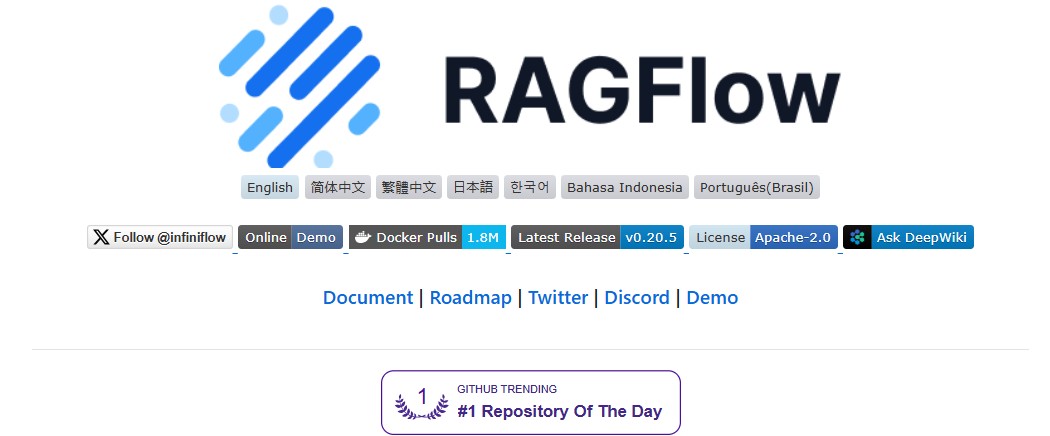Artificial Intelligence is reshaping industries at a pace never seen before. As organizations grapple with vast amounts of structured and unstructured data, there is a growing demand for tools that can make sense of it all with speed, accuracy and context. This is where RAGFlow stands out. Positioned as a next-generation open-source Retrieval-Augmented Generation (RAG) engine, RAGFlow fuses intelligent agents with powerful retrieval techniques to deliver context-rich, reliable outputs for large language models (LLMs).

In this article, we’ll explore what RAGFlow is, its features, architecture, benefits and why it matters for businesses and developers looking to scale AI solutions.
Table of Contents
What is RAGFlow?
It is an open-source RAG engine developed by Infiniflow. Unlike traditional RAG frameworks that focus only on retrieving text chunks, RAGFlow introduces agentic capabilities and a converged context engine that elevates the way LLMs access and process data.
It can work across unstructured documents, multimodal data (such as images, PDFs, and scanned copies) and structured databases. The result is a more reliable, explainable and enterprise-ready AI system that not only finds information but also understands and contextualizes it.
You can check out the official repository here: GitHub Link.
Key Features
1. Deep Document Understanding
At the heart of RAGFlow is DeepDoc, a module designed to parse and extract insights from complex documents. Whether dealing with Word files, PDFs, Excel sheets or image-based content, DeepDoc ensures that no information is left behind, helping enterprises uncover hidden insights.
2. Template-Based Chunking
Unlike traditional chunking methods that cut documents into arbitrary pieces, it uses template-driven chunking. This makes data segmentation explainable, repeatable, and optimized for retrieval, improving both precision and efficiency.
3. Grounded Citations and Reduced Hallucinations
It minimizes the risks of “AI hallucinations” by providing traceable citations. Each generated response can be connected back to its source, ensuring transparency and accountability. Visualization tools allow users to inspect chunking and references, enabling human oversight where needed.
4. Compatibility with Heterogeneous Data
Businesses rarely deal with a single data type. It is built to handle diverse data formats, including text, spreadsheets, images, scanned documents and even web pages. This makes it a versatile choice for enterprises that rely on varied data sources.
5. Automated RAG Workflow
It goes beyond manual orchestration by offering a fully automated pipeline. It combines multiple recall strategies, fused re-ranking and configurable LLMs. Developers can integrate RAGFlow into their systems using intuitive APIs reducing deployment complexity.
System Architecture
RAGFlow’s design is based on two core elements:
- Converged Context Engine – Combines different data sources into a unified context layer that can be fed into LLMs.
- Pre-Built Agent Templates – Provides modular workflows for reasoning, extraction and generation.
The architecture supports both CPU and GPU acceleration making it flexible for deployment across small teams or large enterprises.
Benefits of RAGFlow
- Enhanced Accuracy – By grounding answers in knowledge-backed references, RAGFlow significantly reduces hallucinations.
- Scalability – Handles massive datasets without compromising speed or efficiency.
- Explainability – Every output is traceable, making it ideal for industries like healthcare, law and finance where accountability is critical.
- Faster Time-to-Insight – Automated workflows and agent-driven reasoning accelerate knowledge discovery.
- Enterprise Readiness – Compatible with cloud, on-premises and hybrid environments.
Getting Started with RAGFlow
One of the biggest strengths of RAGFlow is its ease of deployment. The system can be launched locally or in the cloud using Docker.
Prerequisites
- CPU: ≥ 4 cores
- RAM: ≥ 16 GB
- Disk: ≥ 50 GB
- Docker: ≥ 24.0
Deployment Options
- Pre-Built Docker Images – Quick and simple installation.
- GPU-Accelerated Containers – For organizations that need faster embedding and processing.
- Source Code Deployment – Ideal for developers who want complete customization.
The documentation also provides instructions for advanced setups such as integrating external embedding models or switching from Elasticsearch to Infinity for indexing.
Why RAGFlow Matters ?
In today’s data-driven world, the ability to process vast, messy datasets with accuracy and transparency is no longer optional—it’s essential. RAGFlow fills this gap by combining:
- Retrieval-Augmented Generation
- Knowledge extraction
- Agent-driven reasoning
- Scalability and enterprise readiness
Industries like healthcare can use RAGFlow to integrate patient data and medical research for better diagnostics. Finance teams can enhance fraud detection and compliance monitoring. Legal professionals can map case laws and precedents with more precision. The applications are virtually endless.
Conclusion
RAGFlow represents a new era of Retrieval-Augmented Generation, combining robust retrieval techniques with agentic workflows to provide a superior context layer for LLMs. It offers enterprises and developers an open-source, scalable and explainable framework to build AI solutions that truly understand data.
By streamlining document understanding, reducing hallucinations, and enabling multi-format compatibility, It is more than just a RAG engine – it’s a comprehensive AI ecosystem.
If your goal is to unlock actionable insights from complex datasets while maintaining accuracy and transparency, RAGFlow is the tool worth adopting today.
Related Reads
- GraphRAG: The Future of Retrieval-Augmented Generation with Knowledge Graphs
- AgentScope: A Powerful Developer-Centric Framework for Building Agentic Applications
- Eigent: The World’s First Multi-Agent Workforce for Next-Level Productivity
- Pen and Paper Exercises in Machine Learning: A Free Resource to Master ML Fundamentals
- 7 AI Books That Can Teach You More Than a $200K Master’s Degree
References
Documentation — Get Started Guide


5 thoughts on “RAGFlow: Revolutionizing AI with Retrieval-Augmented Generation”